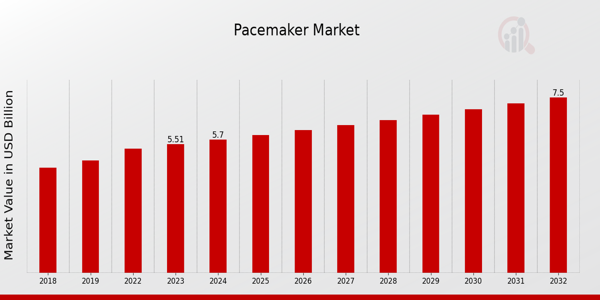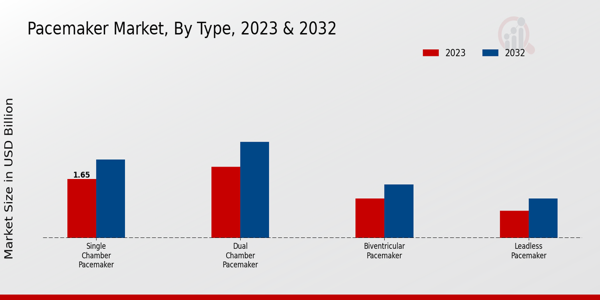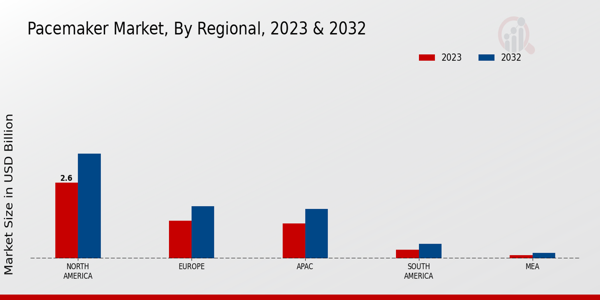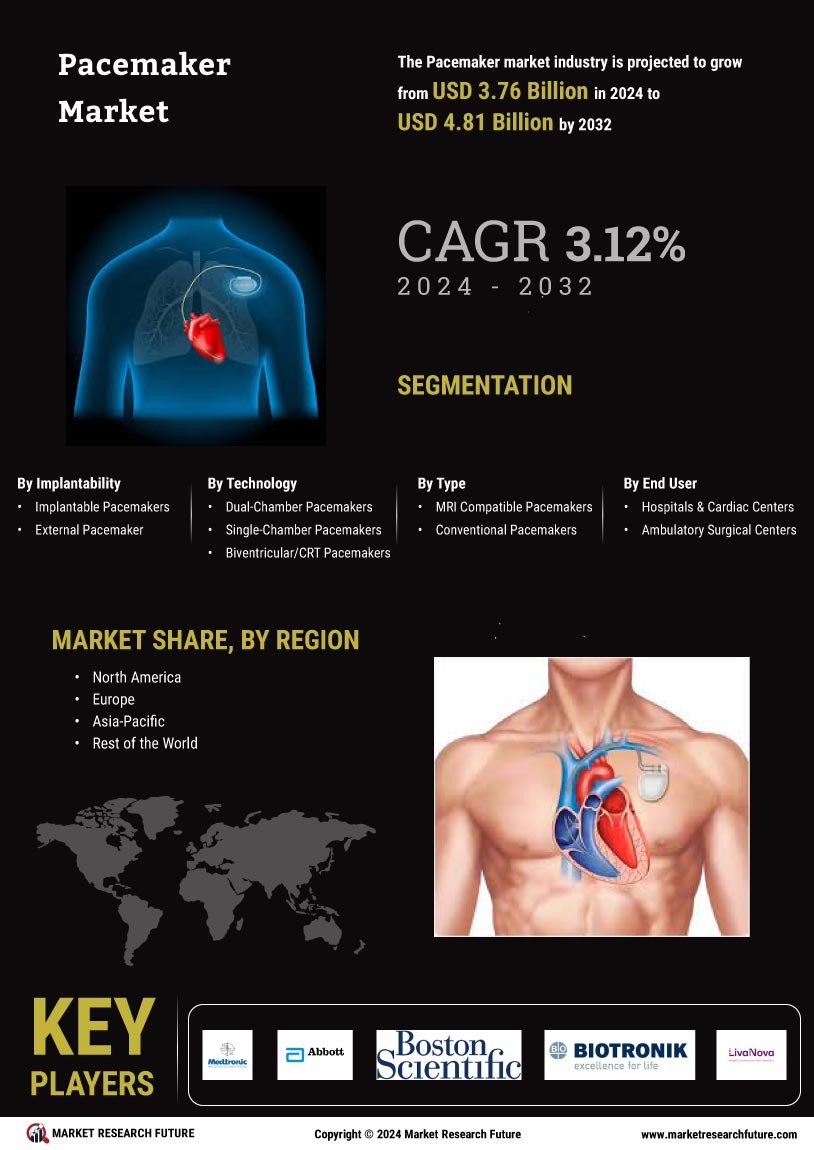Pacemaker Market Overview
As per MRFR analysis, the Pacemaker Market Size was estimated at 5.74 (USD Billion) in 2023. The Pacemaker Market Industry is expected to grow from 5.97(USD Billion) in 2024 to 9.2 (USD Billion) by 2035. The Pacemaker Market CAGR (growth rate) is expected to be around 4.02% during the forecast period (2025-2035).
Key Pacemaker Market Trends Highlighted
The Global Pacemaker Market is experiencing notable trends driven by the increasing prevalence of cardiovascular conditions, which is a leading cause of mortality worldwide, as reported by health authorities. The aging population, particularly in developed regions, further fuels demand for this vital technology, as older individuals are more likely to require cardiac interventions. Additionally, technological advancements in pacemaker design and functionality, including the development of leadless pacemakers, are shaping the market landscape.
These innovations enhance patient comfort and reduce the risk of complications associated with traditional pacemaker systems.Opportunities to be explored in the Global Pacemaker Market include the potential for expansion in emerging markets, where healthcare infrastructure is improving and access to advanced medical devices is on the rise. There is also a growing focus on telemedicine and remote monitoring solutions, allowing healthcare providers to manage patients more efficiently from afar, which presents a lucrative avenue for manufacturers to pursue. Recent trends highlight an increased emphasis on patient-centered care and personalized medicine.
This approach encourages the development of customized pacemaker solutions tailored to individual patient needs, improving overall treatment outcomes.Furthermore, rising health awareness and preventive healthcare initiatives encouraged by global health organizations are fostering a positive environment for market growth. As stakeholders continue to prioritize innovative technologies and enhanced patient experiences, the Global Pacemaker Market is positioned for continual evolution and expansion.

Source: Primary Research, Secondary Research, MRFR Database and Analyst Review
Pacemaker Market Drivers
Growing Prevalence of Cardiac Diseases
The growing incidence of cardiovascular disorders, which are now one of the world's leading causes of death, is a major factor propelling the global pacemaker devices market. The World Health Organization (WHO) estimates that cardiovascular illnesses claimed the lives of 17.9 million people in 2019, accounting for 32% of all fatalities worldwide. The necessity for sophisticated cardiac devices like pacemakers is increasing as a result of the skyrocketing prevalence of hypertension and heart-related conditions.
This pattern demonstrates the pressing need for cutting-edge therapies to successfully manage these long-term illnesses. The global pacemaker devices market is expanding as a result of organizations like the American Heart Association (AHA) investing more money in research projects to create cutting-edge pacemaker technology. As global healthcare systems place a higher priority on heart health advances, the demand for dependable monitoring and treatment solutions will continue to drive this market.
Technological Advancements in Pacemaker Devices
The Global Pacemaker Market Industry is being shaped by rapid technological advancements in pacemaker devices. Innovations such as MRI-compatible devices, leadless pacemakers, and remote monitoring capabilities are enhancing the functionality and safety of these devices. This trend is supported by findings from the Food and Drug Administration, which has approved numerous new pacemaker technologies in recent years, heralding a new era of minimally invasive surgical techniques.
For instance, the introduction of leadless pacemakers has reduced complications associated with traditional pacemaker leads, thus attracting more patients to these advanced options. Such technological innovations not only enhance patient outcomes but also significantly stimulate market dynamics through increased adoption rates across global markets.
Aging Population and Associated Health Concerns
The demographic shift towards an aging population is a significant driver for the Global Pacemaker Market Industry. By 2050, it is estimated that there will be over 2 billion people aged 60 years and older, according to the United Nations. This demographic is more susceptible to cardiovascular diseases, driving the demand for medical devices like pacemakers. Countries such as Japan and Italy are already witnessing this trend, where older adults constitute a large portion of the population, creating a higher demand for effective cardiac management solutions.The aging population, coupled with an increase in lifestyle-related health issues, underscores the increased market potential for pacemakers globally as healthcare systems adapt to cater to their growing needs.
Rising Healthcare Expenditure and Investments in Cardiology
The rise in global healthcare expenditure plays a critical role in driving the Global Pacemaker Market Industry. As nations allocate more resources to healthcare, they focus on improving cardiovascular care. The World Bank reported a significant increase in healthcare spending across various countries, fueled by government policies emphasizing preventive care and technological adoption. For instance, countries like Canada and Germany have significantly increased healthcare budgets, promoting investments in cardiology departments and medical technologies.With greater funding, healthcare institutions can invest in state-of-the-art pacemakers and cardiac care infrastructure, thereby driving the overall market growth. This trend highlights the interconnectedness of economic health and advancements in healthcare technologies, particularly in the cardiology sector.
Pacemaker Market Segment Insights
Pacemaker Market Type Insights
The Global Pacemaker Market is witnessing significant developments across various types of devices designed to address heart rhythm disorders. In 2024, the overall market is valued at 5.97 USD Billion, with a steady rise projected to reach 9.2 USD Billion by 2035. The segmentation by type reveals key insights into the dynamics of the market. The Single Chamber Pacemaker holds a notable position, valued at 1.79 USD Billion in 2024, and is anticipated to grow to 2.68 USD Billion by 2035. This type is primarily used for patients requiring pacing in either the atrium or the ventricle, making it crucial for managing simple cardiac conditions.
Dual Chamber Pacemakers, with a valuation of 2.26 USD Billion in 2024, are particularly significant as they coordinate the contraction of both the atrium and ventricle, fostering more natural heart function; by 2035, this segment is expected to grow to 3.26 USD Billion, affirming its dominance within the Global Pacemaker Market revenue structure. Meanwhile, Biventricular Pacemakers, valued at 1.49 USD Billion in 2024, focus on cardiac resynchronization therapy, providing essential support for patients with heart failure.
This segment projects a growth of 2.07 USD Billion by 2035, indicating its increasing relevance in modern cardiovascular therapy.The Leadless Pacemaker, although newer and thus smaller in valuation at 0.43 USD Billion in 2024, showcases rapid advancements in minimally invasive technologies and is expected to reach 0.89 USD Billion by 2035. Its appeal lies in its reduced complication rates and lower infection risks, which are essential factors driving market growth. The Global Pacemaker Market segmentation showcases diverse opportunities shaped by evolving technologies and shifting patient needs, catering to an array of cardiovascular conditions while addressing both innovation and clinical efficacy in global healthcare.

Source: Primary Research, Secondary Research, MRFR Database and Analyst Review
Pacemaker Market Technology Insights
The Technology segment of the Global Pacemaker Market has shown substantial growth, contributing significantly to the overall market trends. In 2024, the market is valued at approximately 5.97 USD Billion, reflecting the increasing demand for advanced pacing technologies. The segmentation of technology within the Global Pacemaker Market includes Transvenous Pacemakers, Epicardial Pacemakers, and Wireless Pacemakers, each playing a crucial role in addressing specific cardiac needs. Transvenous Pacemakers are often preferred due to their minimally invasive nature, allowing for easier implantation procedures and improved patient recovery times.
Epicardial Pacemakers are particularly important in specific situations such as surgery or for patients with existing heart complications, offering effective solutions in critical care. Wireless Pacemakers, with their unique design that eliminates the need for leads, represent a significant innovation, reducing the risk of infection and enhancing patient comfort. This diverse technology segmentation within the Global Pacemaker Market illustrates not only the variety of options available to healthcare professionals but also addresses the growing demand for personalized cardiac care solutions, ultimately driving market growth and innovation.
Pacemaker Market End Use Insights
The Global Pacemaker Market is significantly influenced by its End Use segmentation, which includes Hospitals, Cardiac Care Centers, and Ambulatory Surgical Centers. In 2024, the overall market is valued at 5.97 billion USD, showing a growing demand driven by an increase in cardiovascular diseases and an aging population. Hospitals have traditionally dominated this market due to their advanced facilities and specialized cardiac care, providing essential services and technologies for pacemaker implantation. Cardiac Care Centers play a crucial role as they focus specifically on cardiac patients, offering tailored services and improved patient outcomes, which enhance their importance in the ecosystem.
Additionally, Ambulatory Surgical Centers are gaining momentum by providing minimally invasive procedures and shorter recovery times, appealing to the increasing demand for outpatient care. This trend towards outpatient services reflects the changing preferences of patients seeking efficient, cost-effective treatment options. The Global Pacemaker Market statistics highlight the growth potential within these End Use categories, as healthcare providers continue to invest in advanced technologies and infrastructure to meet the needs of patients. Challenges such as regulatory hurdles and high costs of devices remain, yet opportunities for innovation and expansion persist in this evolving landscape.
Pacemaker Market Component Insights
In the Global Pacemaker Market, the Component segment plays a crucial role, contributing significantly to the overall market dynamics. In 2024, this market is valued at 5.97 USD Billion, showcasing robust growth potential. Key components such as Pulse Generators, Leads, Electrodes, and Programming Devices are fundamental to the functionality and effectiveness of pacemakers. The Pulse Generator serves as the heart of the system, regulating the electrical impulses needed for pacing. Leads are vital for connecting the pulse generator to the heart, ensuring accurate delivery of impulse signals.Electrodes facilitate the transmission of these signals, reinforcing their importance in maintaining proper cardiac rhythm.
Programming Devices enable healthcare professionals to easily adjust and monitor pacemaker settings, enhancing patient management. With growing aging populations and increasing incidences of cardiac diseases globally, these components are driving the market forward. The segment is set to witness continuous innovations and improvements in technology, creating opportunities for enhanced patient outcomes and market growth. As the Global Pacemaker Market continues to expand, these components are expected to dominate the landscape, reflecting the ongoing advancement in cardiac care.
Pacemaker Market Regional Insights
The Global Pacemaker Market revenue is poised for growth, with a significant contribution from various regions. In 2024, North America leads the market, valued at 2.5 USD Billion, reflecting its advanced healthcare infrastructure and a high prevalence of cardiac disorders, which drives demand. Europe follows, valued at 1.6 USD Billion, supported by a robust regulatory framework and increasing patient access to medical technologies. In the APAC region, the market is valued at 1.2 USD Billion in 2024, presenting opportunities for expansion due to rising healthcare investments and improving medical facilities despite facing challenges like varying regulatory standards.
South America, valued at 0.4 USD Billion, is emerging gradually, offering the potential for growth driven by increasing awareness about cardiac health. Meanwhile, the MEA region, valued at 0.3 USD Billion, remains the smallest market but is gradually developing, influenced by investment in healthcare and growing healthcare needs. The Global Pacemaker Market segmentation illustrates the dominance of North America, which holds a majority share due to its sophisticated medical technology landscape, while the growth drivers across regions also highlight opportunities for innovation and market expansion.

Source: Primary Research, Secondary Research, MRFR Database and Analyst Review
Pacemaker Market Key Players and Competitive Insights
The Global Pacemaker Market is characterized by a dynamic competitive landscape, influenced by advancements in technology, increasing prevalence of cardiovascular diseases, and a growing aging population. Key players in the market are continually innovating, focusing on the development of next-generation pacemakers that offer enhanced features such as MRI-compatibility, wireless connectivity, and improved battery longevity. As competitors strive to capture larger market shares, strategic partnerships, mergers, and acquisitions have become common trends, enabling companies to expand their product portfolios and enhance their global reach.
Furthermore, regulatory approvals play a crucial role in shaping the competitive dynamics, as companies must navigate complex frameworks to launch new products in various regions. Sorin Group is recognized for its strong foothold in the Global Pacemaker Market, concentrating on providing a comprehensive range of cardiac rhythm management devices. The company has established itself through a commitment to innovative technologies and quality manufacturing processes. With a focus on patient safety and efficacy, Sorin Group emphasizes the development of advanced products that cater to the evolving needs of healthcare professionals worldwide.
Their strength lies in robust research and development capabilities, which facilitate the introduction of breakthrough devices that enhance patient care. Sorin Group's manufacturing excellence, combined with strategic partnerships, has positioned it as a reliable brand within the competitive landscape of the pacemaker market.Abbott Laboratories, a key player in the Global Pacemaker Market, offers a wide array of advanced cardiac devices, including implantable pacemakers and cardiac monitors. Their key product line includes devices that feature cutting-edge technology designed to improve patient outcomes and healthcare efficiency. Abbott has established a strong market presence driven by innovation and significant investment in research and development.
The company's strengths include a well-established global distribution network and strategic acquisitions that have broadened its product offerings and market reach. By continuously enhancing its product capabilities and focusing on customer engagement, Abbott Laboratories has cemented its reputation as a leader in the cardiovascular device market, contributing to its overall success in the global arena.
Key Companies in the Pacemaker Market Include
- Sorin Group
- Abbott Laboratories
- AngioDynamics
- Zoll Medical
- Cook Medical
- AtriCure
- LivaNova
- Osypka Medical
- Medtronic
- Biotronik
- St. Jude Medical
- Shenzhen Mindray BioMedical Electronics
- Boston Scientific
- Pacira Biosciences
Pacemaker Market Industry Developments
The Global Pacemaker Market has seen significant developments recently. Notable advancements include the FDA's approval of enhanced pacemaker technologies that improve patient monitoring and offer advanced functionalities essential in cardiac care. Companies like Abbott Laboratories and Medtronic continue to invest in Research and Development, leading to innovations that enhance device battery life and remote patient management capabilities. In September 2023, Abbott Laboratories announced a collaborative effort with a leading biotechnology firm to integrate artificial intelligence into pacemaker functionality aimed at improving predictive analytics for patient heart health.
Additionally, the market has experienced notable growth in valuation, with companies expanding their product portfolios to cater to the increasing demand for minimally invasive procedures and portable pacemaker options. Despite the competitive landscape, prominent players like Biotronik and Boston Scientific have made strides in expanding their geographical reach, particularly in emerging markets within Asia and Latin America. A merger was announced in July 2023, involving AngioDynamics acquiring a specialty medical device company to bolster its cardiac business segment, which aligns with the ongoing consolidation trend in the industry. Such activities indicate a robust trajectory for growth amid evolving patient needs and technological advancements.
Pacemaker Market Segmentation Insights
Pacemaker Market Type Outlook
- Single Chamber Pacemaker
- Dual Chamber Pacemaker
- Biventricular Pacemaker
- Leadless Pacemaker
Pacemaker Market Technology Outlook
- Transvenous Pacemakers
- Epicardial Pacemakers
- Wireless Pacemakers
Pacemaker Market End Use Outlook
- Hospitals
- Cardiac Care Centers
- Ambulatory Surgical Centers
Pacemaker Market Component Outlook
- Pulse Generator
- Leads
- Electrodes
- Programming Device
Pacemaker Market Regional Outlook
- North America
- Europe
- South America
- Asia Pacific
- Middle East and Africa
| Report Attribute/Metric Source: |
Details |
| MARKET SIZE 2023 |
5.74(USD Billion) |
| MARKET SIZE 2024 |
5.97(USD Billion) |
| MARKET SIZE 2035 |
9.2(USD Billion) |
| COMPOUND ANNUAL GROWTH RATE (CAGR) |
4.02% (2025 - 2035) |
| REPORT COVERAGE |
Revenue Forecast, Competitive Landscape, Growth Factors, and Trends |
| BASE YEAR |
2024 |
| MARKET FORECAST PERIOD |
2025 - 2035 |
| HISTORICAL DATA |
2019 - 2024 |
| MARKET FORECAST UNITS |
USD Billion |
| KEY COMPANIES PROFILED |
Sorin Group, Abbott Laboratories, AngioDynamics, Zoll Medical, Cook Medical, AtriCure, LivaNova, Osypka Medical, Medtronic, Biotronik, St. Jude Medical, Shenzhen Mindray BioMedical Electronics, Boston Scientific, Pacira Biosciences |
| SEGMENTS COVERED |
Type, Technology, End Use, Component, Regional |
| KEY MARKET OPPORTUNITIES |
Rising prevalence of cardiovascular diseases, Technological advancements in pacemaker devices, Growing demand for wireless pacemakers, Increased aging population globally, Expanding healthcare infrastructure in emerging markets |
| KEY MARKET DYNAMICS |
Increasing geriatric population, Rising cardiovascular diseases, Advancements in technology, Growing demand for minimally invasive procedures, Regulatory approvals and compliance |
| COUNTRIES COVERED |
North America, Europe, APAC, South America, MEA |
Pacemaker Market Highlights:
Frequently Asked Questions (FAQ) :
The Global Pacemaker Market is expected to be valued at 5.97 billion USD in 2024.
The market is projected to reach a value of 9.2 billion USD by 2035.
The expected CAGR for the market is 4.02% during the period from 2025 to 2035.
North America is expected to dominate the market with a value of 2.5 billion USD in 2024.
By 2035, the market size in Europe is expected to reach 2.5 billion USD.
The market value for Single Chamber Pacemakers is expected to be 1.79 billion USD in 2024.
Key players in the market include Medtronic, Abbott Laboratories, and Boston Scientific among others.
The market for Dual Chamber Pacemakers is expected to generate 3.26 billion USD by 2035.
Challenges include stringent regulatory requirements and technological advancements in cardiac devices.
The market value for Leadless Pacemakers is projected to reach 0.89 billion USD by 2035.

















